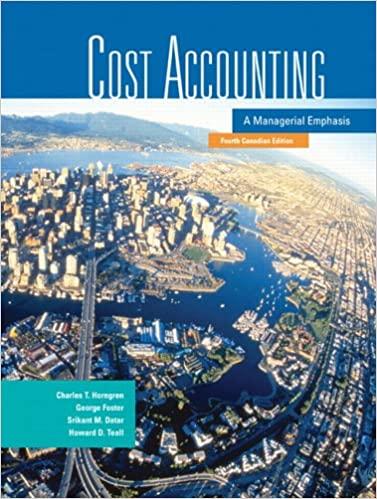Question
I just need question 2 & 3? Weighted Average Cost Method with Perpetual Inventory The beginning inventory at Midnight Supplies and data on purchases and
I just need question 2 & 3?
Weighted Average Cost Method with Perpetual Inventory
The beginning inventory at Midnight Supplies and data on purchases and sales for a three-month period ending March 31, are as follows:
| Date | Transaction | Number of Units | Per Unit | Total | ||||
|---|---|---|---|---|---|---|---|---|
| Jan. 1 | Inventory | 7,500 | $75.00 | $562,500 | ||||
| 10 | Purchase | 22,500 | 85.00 | 1,912,500 | ||||
| 28 | Sale | 11,250 | 150.00 | 1,687,500 | ||||
| 30 | Sale | 3,750 | 150.00 | 562,500 | ||||
| Feb. 5 | Sale | 1,500 | 150.00 | 225,000 | ||||
| 10 | Purchase | 54,000 | 87.50 | 4,725,000 | ||||
| 16 | Sale | 27,000 | 160.00 | 4,320,000 | ||||
| 28 | Sale | 25,500 | 160.00 | 4,080,000 | ||||
| Mar. 5 | Purchase | 45,000 | 89.50 | 4,027,500 | ||||
| 14 | Sale | 30,000 | 160.00 | 4,800,000 | ||||
| 25 | Purchase | 7,500 | 90.00 | 675,000 | ||||
| 30 | Sale | 26,250 | 160.00 | 4,200,000 | ||||
Required:
1. Record the inventory, purchases, and cost of merchandise sold data in a perpetual inventory record similar to the one illustrated in Exhibit 5, using the weighted average cost method. Round unit cost to two decimal places, if necessary.
| Midnight Supplies Perpetual Inventory Account Weighted Average Cost Method For the three months ended March 31 | |||||||||
|---|---|---|---|---|---|---|---|---|---|
| Purchases | Cost of Merchandise Sold | Inventory | |||||||
| Date | Quantity | Unit Cost | Total Cost | Quantity | Unit Cost | Total Cost | Quantity | Unit Cost | Total Cost |
| Jan. 1 | fill in the blank 1 | $fill in the blank 2 | $fill in the blank 3 | ||||||
| Jan. 10 | fill in the blank 4 | $fill in the blank 5 | $fill in the blank 6 | fill in the blank 7 | fill in the blank 8 | fill in the blank 9 | |||
| Jan. 28 | fill in the blank 10 | $fill in the blank 11 | $fill in the blank 12 | fill in the blank 13 | fill in the blank 14 | fill in the blank 15 | |||
| Jan. 30 | fill in the blank 16 | fill in the blank 17 | fill in the blank 18 | fill in the blank 19 | fill in the blank 20 | fill in the blank 21 | |||
| Feb. 5 | fill in the blank 22 | fill in the blank 23 | fill in the blank 24 | fill in the blank 25 | fill in the blank 26 | fill in the blank 27 | |||
| Feb. 10 | fill in the blank 28 | fill in the blank 29 | fill in the blank 30 | fill in the blank 31 | fill in the blank 32 | fill in the blank 33 | |||
| Feb. 16 | fill in the blank 34 | fill in the blank 35 | fill in the blank 36 | fill in the blank 37 | fill in the blank 38 | fill in the blank 39 | |||
| Feb. 28 | fill in the blank 40 | fill in the blank 41 | fill in the blank 42 | fill in the blank 43 | fill in the blank 44 | fill in the blank 45 | |||
| Mar. 5 | fill in the blank 46 | fill in the blank 47 | fill in the blank 48 | fill in the blank 49 | fill in the blank 50 | fill in the blank 51 | |||
| Mar. 14 | fill in the blank 52 | fill in the blank 53 | fill in the blank 54 | fill in the blank 55 | fill in the blank 56 | fill in the blank 57 | |||
| Mar. 25 | fill in the blank 58 | fill in the blank 59 | fill in the blank 60 | fill in the blank 61 | fill in the blank 62 | fill in the blank 63 | |||
| Mar. 30 | fill in the blank 64 | fill in the blank 65 | fill in the blank 66 | fill in the blank 67 | fill in the blank 68 | fill in the blank 69 | |||
| Mar. 31 | Balances | $fill in the blank 70 | $fill in the blank 71 | ||||||
2. Determine the total sales, the total cost of merchandise sold, and the gross profit from sales for the period.
| Total sales | $fill in the blank 72 |
| Total cost of merchandise sold | $fill in the blank 73 |
| Gross profit from sales | $fill in the blank 74 |
3. Determine the ending inventory cost as of March 31. $fill in the blank 75
Step by Step Solution
There are 3 Steps involved in it
Step: 1

Get Instant Access to Expert-Tailored Solutions
See step-by-step solutions with expert insights and AI powered tools for academic success
Step: 2

Step: 3

Ace Your Homework with AI
Get the answers you need in no time with our AI-driven, step-by-step assistance
Get Started


